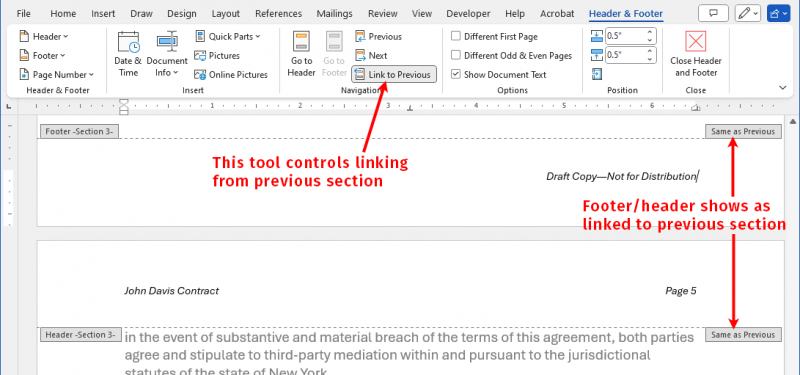Please Note: This article is written for users of the following Microsoft Word versions: 2007, 2010, 2013, 2016, 2019, 2021, and Word in Microsoft 365. If you are using an earlier version (Word 2003 or earlier), this tip may not work for you. For a version of this tip written specifically for earlier versions of Word, click here: Suppressing Headers or Footers.
Written by Allen Wyatt (last updated September 6, 2024)
This tip applies to Word 2007, 2010, 2013, 2016, 2019, 2021, and Word in Microsoft 365
Many people who come to Word from a WordPerfect environment are curious as to how you can suppress headers and footers in your document. While WordPerfect makes this very easy, the method used in Word is much more flexible (albeit nowhere near as easy).
Word allows you to create headers and footers for each section of your document. (This is a critical point to keep in mind, so it bears repeating: Word ties headers and footers to sections and allows you to modify the header or footer on a section-by-section basis.) Thus, if you have eight sections in your document, each section can have its own header and footer. By default, headers and footers for any new sections are the same as the section just before it. If you want to suppress the existing header or footer in a particular section of your document, follow these steps:

Figure 1. Modifying the linkage of the header or footer.
Now, if you preview your document or print it out, you can see there are headers or footers in each section except the one where you deleted them.
The foregoing steps work fine if you want to suppress a header or footer on a page other than the first page of a section. (Remember—headers and footers are tied to sections and can vary for each section in a document.) If you want to only suppress headers or footers on the first page of each section in your document—perhaps you have one section for each chapter in a book-length document and you want to suppress the header or footer on the first page of each chapter—then follow these steps:
WordTips is your source for cost-effective Microsoft Word training. (Microsoft Word is the most popular word processing software in the world.) This tip (9383) applies to Microsoft Word 2007, 2010, 2013, 2016, 2019, 2021, and Word in Microsoft 365. You can find a version of this tip for the older menu interface of Word here: Suppressing Headers or Footers.

Discover the Power of Microsoft Office This beginner-friendly guide reveals the expert tips and strategies you need to skyrocket your productivity and use Office 365 like a pro. Mastering software like Word, Excel, and PowerPoint is essential to be more efficient and advance your career. Simple lessons guide you through every step, providing the knowledge you need to get started. Check out Microsoft Office 365 For Beginners today!
When you attach a template to a document, it doesn't modify the documents headers or footers. This tip provides three ...
Discover MoreGetting a word count for an entire document is rather easy. If you want a word count for a special part of a document ...
Discover MoreHeaders and footers add a nice touch to your documents, particularly if they are printed. You may want Word to use a ...
Discover MoreFREE SERVICE: Get tips like this every week in WordTips, a free productivity newsletter. Enter your address and click "Subscribe."
There are currently no comments for this tip. (Be the first to leave your comment—just use the simple form above!)
Got a version of Word that uses the ribbon interface (Word 2007 or later)? This site is for you! If you use an earlier version of Word, visit our WordTips site focusing on the menu interface.
Visit the WordTips channel on YouTube
FREE SERVICE: Get tips like this every week in WordTips, a free productivity newsletter. Enter your address and click "Subscribe."
Copyright © 2025 Sharon Parq Associates, Inc.
Comments